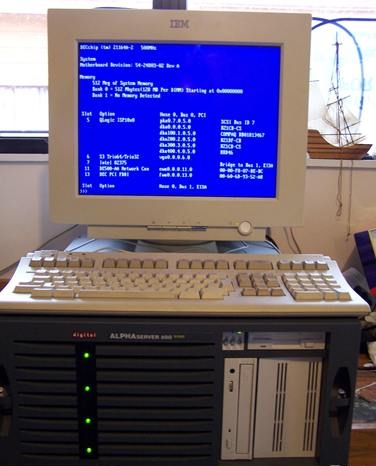
CPU: one 64bit Alpha/AXP 21164A CPU at 333MHz, 400MHz or 500MHz
Video: integrated S3
Max Ram: up to 2GB ECC
chassis: Rackmount and tower
bus: 3 PCI, 2 EISA, 1 PCI-64bit/ISA slots
Menu:

The AlphaServer 800 comes in both Rackmount and tower forms. It supports a single EV5 CPU at either 333MHz, 400Mhz or 500MHz and up to 2GB of RAM. Disk Storage comes in the form of four hot-swap drive bays in the front (not storageworks type). It was announced in October 1997 starting at US$15,499 for the 5/500 model (around US$30k in 2023).


Most of the ports on the rear of the machine should be fairly obvious - regular PC compatible VGA, Parallel (printer), PS/2 keyboard and PS/2 mouse ports. On the left side we've got two DE9M ports; the upper one marked with an up arrow in a box is for connecting a modem for remote management, while the lower one with two arrows and the number 2 is the second serial port. The weird one on the far left that looks like some kind of phone jack is the first serial port which uses a DECconnect MMJ jack - this is where you'd connect a terminal if you need to.
If you get nothing out of the VGA port except a blue screen when you start up the machine, you'll need to use a serial terminal to access the console firmware. The AlphaServer 800 is a bit awkward in this regard as the console port is a DECconnect MMJ port. Unless you happent to have an MMJ cable and suitable terminal (VT320/420/520), you'll need to wire up an adapter. MMJ crimp plugs and compatible crimpers can still be bought new and are fairly inexpensive, but if you're desperate you can break the tab off of a regular 6P6C plug and accept that the cable will come out of the computer annoyingly easily.
If you're connecting up to a real terminal, the appropriate adapters are: H8571-A (MMJ to DB25F), H8575-D (H8571-A with better ESD protection) or H8571-J (MMJ to DE9F). When used with a PC these adapters will require use of a crossover MMJ cable. Wiring diagrams for these adapters and others can be found here: DEC MMJ serial adapters and cables
When using a terminal emulator, the correct communications settings should be: 9600 baud, 8 bits, no parity, one stop bit (9600 baud, 8N1). If you're using C-Kermit, the commands would be:
set term type vt320 ; C-Kermit for Windows only: emulate a VT320 set term remote latin1-iso set carrier off set port com1 ; or /dev/ttyUSB1, etc, on linux set speed 9600 set parity none set stop-bits 1 set flow none connect
The AlphaServer 800 is equipped with a remote management console which can be accessed via either dial-up modem (on the remote console modem port), terminal or terminal emulator (on the MMJ console port) or on the graphics console via the rmc commmand.
By default to access it with a terminal or terminal emulator, send the RMC Escape sequence which is, by default, ^]^]rmc. If you're using C-Kermit for Windows as your terminal emulator with the default key bindings you would do this by hitting Ctrl+] four times then typing rmc (One Ctrl+] for the local escape, next Ctrl+] to send an escape, repeated twice).
RMC>status
PLATFORM STATUS
Firmware Revision: V3.0
Server Power: ON
Fanstate: OK
System Halt: Asserted
Temperature: 25.0° C (warnings at 46.0° C, power-off at 52.0° C)
RMC Power Control: ON
Escape Sequence: ^[^[RMC
Remote Access: Disabled
Modem Password: not set
Alert Enable: Disabled
Alert Pending:
Init String:
Dial String:
Alert String:
Modem and COM1 baud: 9600
Last Alert: Power Failure
Watchdog Timer: 60 seconds
Autoreboot: OFF
User String:
The AlphaServer 800 has two battery-backed memory devices: a Dallas DS1287 real time clock and a Dallas DS1225AD-150 non-volatile SRAM. If the battery inside the DS1287 fails the SRM console won't remember its settings anymore. The machine will default to a serial console and OpenVMS as the OS Type. You can still boot Digital UNIX or OpenVMS just fine, but you'll need a serial terminal connected to help the machine boot. The DS1225AD-150 stores the EISA configuration so when it fails it will need replacing too.
If the machine is running Windows, a flat RTC battery is a slightly bigger problem:
![[AlphaBIOS Expired battery Security Warning]](images/arc-flat-battery.png)
The DS12887+ works fine as a replacement for the DS1287 in the AlphaServer 800, and the DS1225AD-150 can be safely replaced with a DS1225AD-150+.
There are two flavours of the EISA Configuration Utiltiy (ECU): One for Windows NT and one for OpenVMS and Digital UNIX. The only difference between the two are the .cfg files on the disk - Windows NT supports sharing interrupts where as OpenVMS and Digital UNIX do not. If the machine was previously configured with the Windows NT version of the ECU and you want to run OpenVMS or Digital UNIX you'll likely need to run OpenVMS/Digital UNIX version of the ECU first. You'll also need to run the ECU if you replace the DS1225AD-150 NVRAM chip.
I'm not sure which ECU version was shipped with the AlphaServer 800 originally, but v1.11a appears to be the latest version: Download Alpha ECU 1.11A for Digital UNIX and OpenVMS (disk image) or Download Alpha ECU 1.11A for Windows NT (zip file - copy contents to disk)
The latest firmware versions are ARC v5.70 and SRM v5.8-16 which can be found on the Alpha Systems Firmware Update 6.3 CD.
I currently have two of these machines, both in rack-mount form: